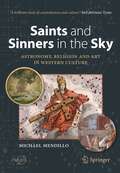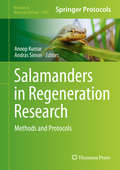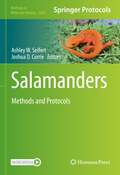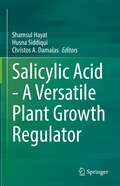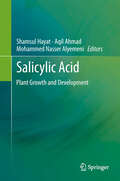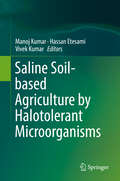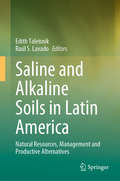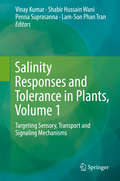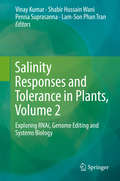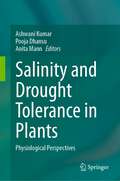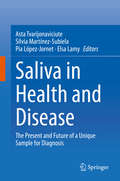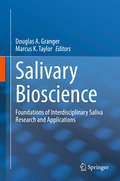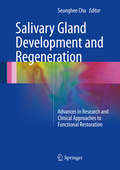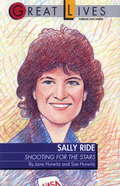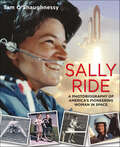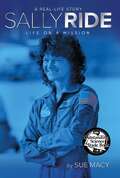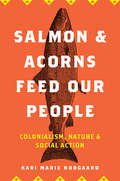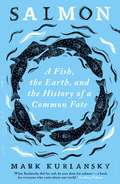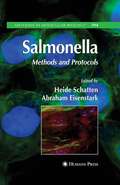- Table View
- List View
Saint Joan of New York: A Novel About God and String Theory (Science and Fiction)
by Mark AlpertSAINT JOAN OF NEW YORK is a novel about a math prodigy who becomes obsessed with discovering the Theory of Everything. Joan Cooper, a 17-year-old genius traumatized by the death of her older sister, tries to rebuild her shattered world by studying string theory and the efforts to unify the laws of physics. But as she tackles the complex equations, she falls prey to disturbing visions of a divine being who wants to help her unveil the universe’s mathematical design. Joan must enter the battle between science and religion, fighting for her sanity and a new understanding of the cosmos.
Saints and Sinners in the Sky: Astronomy, Religion and Art in Western Culture (Springer Praxis Books)
by Michael Mendillo"A brilliant study of constellations and culture." - Neil deGrasse TysonIn this book, Boston University Professor of Astronomy Michael Mendillo takes readers deep into the annals of history, showing how visual depictions of the heavens evolved in tandem with science and religion throughout much of Western culture. With unprecedented scope and scale, Professor Mendillo explores how cave art, illuminated manuscripts, sculptures, paintings and architecture reflected some of the great religious and secular battles taking place over the course of centuries. Enter a world of biblical proportions, where constellations of ancient heroes and pagans were thoroughly recast as Christian saints and the Twelve Apostles. This nontechnical narrative brings vitality and accessibility to some of the most enduring subjects in human history, offering a lively new exploration of the visual connections between celestial phenomena and artistic expression."Saints and Sinners impressionistically reveals the connections of art, astronomy, and religion in Western culture to illuminate the age-old quest for celestial-terrestrial connections.” - Roberta J.M. Olson, author of Giotto’s Portrait of Halley’s Comet and Cosmos: The Art and Science of the Universe “Professor Mendillo’s book does a priceless service, opening the doors of our minds to images that will stir us, because the heavens are part of us, and we all long to know how and why.” - Rev. David R. Thom, MIT Chaplain and Convener of the Cambridge Faculty Roundtable on Science, Art & Religion "Over a lifetime devoted to astronomical research and teaching, Michael Mendillo has indulged a parallel passion for artistic representations of the heavenly bodies. In this sumptuous volume, he explores the projection of our changing belief systems onto the constant stars.” - Dava Sobel, author of Longitude, Galileo’s Daughter and The Glass Universe
Salamander Song
by Ginny NeilA spring refrain! A salamander rain! This lush, lyrical story illuminates the convergence of wildlife and citizen science--and the big impact young readers can have on vulnerable species. Salamanders and children alike hear the rhythms and song of the seasons as winter gives way to spring. Salamanders begin to squirm and stretch in the early spring sun, while the children and their teacher plan. They meet on a night of salamander rain (the first warm rain of spring), when the children and their teacher work to help the salamanders cross a busy road to the vernal pool on the other side. This lyrical, parallel narrative story reinforces the idea that kids can make a big difference. The author's note includes information about amphibian migrations and descriptions of citizen science activities that kids can participate in to help keep the world wild and beautiful.
Salamanders in Regeneration Research
by Anoop Kumar András SimonThis detailed volume focuses on best practices and conditions for maintaining the most commonly used salamander species in the laboratory. Salamanders in Regeneration Research: Methods and Protocols guides readers through experimental manipulations in vivo and in vitro, respectively. With methods on targeting a wide variety of structures, ranging from the limb to the heart and to the brain, and methods for studying genetically modified organisms and tools for mining in the genomic databases. Written in the highly successful Methods in Molecular Biology series format, chapters include introduction to their respective topics, lists of the necessary materials and reagents, step-by-step, readily reproducible laboratory protocols, and tips on troubleshooting and avoiding known pitfalls. Authoritative and up-to-date, Salamanders in Regeneration Research: Methods and Protocols provides a comprehensive collection of methods chapters.
Salamanders: Methods and Protocols (Methods in Molecular Biology #2562)
by Ashley W. Seifert Joshua D. CurrieThis volume provides a comprehensive reference for researchers aiming to bring new techniques and approaches to their scientific research using urodeles. Chapters are authored by leaders in the field and meant to guide readers through laboratory colony husbandry, traditional molecular techniques, experimental manipulation and surgeries, bioinformatics and genomics, transgenics and lineage-tracing, and physiological and organismal techniques. In addition to laboratory methods, this volume highlights techniques developed for field studies and work with wild-caught animals. Written in the successful Methods in Molecular Biology series format, chapters include introductions to their respective topics, lists of the necessary materials and reagents, step-by-step, readily reproducible protocols, and notes on troubleshooting and avoiding known pitfalls. Authoritative and state-of-the-art, Methods in Salamander Research aims to be a practical guide for researchers interested in deploying new methodologies in their lab or in the field.
Salicylic Acid - A Versatile Plant Growth Regulator
by Shamsul Hayat Husna Siddiqui Christos A. DamalasPhytohormones are known to affect the growth and development of plant directly as well as indirectly. Salicylic acid (SA) is a phenolic phytohormone which induces systemic resistance in plants and also regulates defence responses. The derivatives of SA also play an important role in the regulation of various physiological and developmental processes in plants under normal and stressful environmental conditions. SA regulates seed germination, photosynthesis, ethylene biosynthesis, enzyme activities, nutrition, flowering, legume nodulation and overall growth and development of plant. Recently, advancement in elucidating the specific pathways of SA signal transduction has been noticed which helps in understanding the expression of specific genes associated with different developmental programs. The horizon of SA-mediated regulation of various physiological processes has also expanded, and various studies enumerating the efficacy of exogenously applied SA in practical agriculture have also been documented. Therefore, information regarding such recent developments needs to be compiled in the form of a book. This book aims to provide a collective information regarding SA which makes it a versatile plant growth regulator. The chapters included both theoretical and practical aspects that could be of immense use for researches and possible significant developments in future. It is intended that this book will be a help for students, teachers, and researchers, in understanding the relation between the phytohormone and agricultural sciences.
Salicylic Acid: Plant Growth and Development
by Shamsul Hayat Mohammed Nasser Alyemeni Aqil AhmadThe book "Salicylic acid: A Plant Hormone" was first published in 1997 and was praised for its excellent balance of traditional and modern topics. This time, we're building on the success of the prior edition to provide an even more effective second edition. The present book is comprised of 16 chapters highlighting the updated mechanisms of its biosynthesis, physiological role, its action in response to water deficit, relationship of SA with signal transduction, transport of SA and related compounds. Further, the interplay between environmental signals and SA, its impact on transport and distribution of sugars, salicylic acid mediated stress-induced flowering and some aspects of interplay of SA with JA during the establishment of plant resistance to pathogens with different types of nutrition and participation of peroxidases have also been discussed at length. Potential use of SA in food production and its efficiency on post-harvest of perishable crops as well as practical use of SA are also covered.
Saline Soil-based Agriculture by Halotolerant Microorganisms
by Manoj Kumar Vivek Kumar Hassan EtesamiThis book discusses the role of salt in current agricultural approaches, including the low salt tolerance of agricultural crops and trees, impact of saline soils, and salt-resistant plants. Halophytes are extremely salt tolerant plants, which are able to grow and survive under salt at concentrations as high as 5 g/l by maintaining negative water potential. The salt-tolerant microbes inhabiting the rhizospheres of halophytes may contribute to their salt tolerance, and the rhizospheres of halophytic plants provide an ideal opportunity for isolating various groups of salt-tolerant microbes that could enhance the growth of different crops under salinity stress. The book offers an overview of salt-tolerant microbes' ability to increase plant tolerance to salt to facilitate plant growth, the potential of the halophytes’ rhizospheres as a reservoir of beneficial salt-tolerant microbes, their future application as bio-inoculants in agriculture and a valuable resource for an alternative way of improving crop tolerance to salinity and promoting saline soil-based agriculture. This special collection of reviews highlights some of the recent advances in applied aspects of plant (halophytes)-microbe interactions and their contribution towards eco-friendly approaches saline soil-based agriculture.
Saline and Alkaline Soils in Latin America: Natural Resources, Management and Productive Alternatives
by Edith Taleisnik Raúl S. LavadoThis book provides the first comprehensive overview of saline and alkaline soils in Latin America, known for having one of the most extensive surface of salt-affected soils in the world. It is organized along two main axes: soils and vegetation. The book discusses the occurrence of such soils in the region, focusing mainly in management strategies for their sustainable use, and it presents accounts of natural vegetation and crops in the various environments of the region. Social impacts of such conditions and ongoing projects to overcome them are considered. Likewise, the book highlights physiological mechanisms that are responsible for the negative effects these soils exert on crops and forest resources and determine vegetation distribution in them. Plant breeding challenges and new perspectives for such environments are discussed. Technologies such as irrigation and drainage are included. The readership includes soil and plant scientists, as well as policy makers.
Salinity Resilience and Sustainable Crop Production Under Climate Change (Earth and Environmental Sciences Library)
by Hassan Auda AwaadThe book provides a comprehensive review of the rapidly expanding and includes in-depth discussions on salinity resilience, sustainable production under climate change, how do plants resilience saline conditions?, Beside Genetic Diversity and inheritance of resistance to Salinity. Furthermore, covers a vast array of special topics and applications illustrating the wide use recent approach of techniques and measurements of assessing genotypes for salinity resilienceThis book has been prepared and supported by recent references and statistics with tables and colourful figures to deliver recent advances to the audience of lower and upper undergraduate, and professional/Practitioner researchers at universities and research centers in the fields of crop breeding and production, physiology, genetics, molecular biology and biotechnology, and allied fields such as agro ecology, sustainable agriculture, climate-resilient agriculture.
Salinity Responses and Tolerance in Plants, Volume 1: Targeting Sensory, Transport And Signaling Mechanisms
by Vinay Kumar Penna Suprasanna Lam-Son Phan Tran Shabir Hussain WaniSoil salinity is a key abiotic-stress and poses serious threats to crop yields and quality of produce. Owing to the underlying complexity, conventional breeding programs have met with limited success. Even genetic engineering approaches, via transferring/overexpressing a single ‘direct action gene’ per event did not yield optimal results. Nevertheless, the biotechnological advents in last decade coupled with the availability of genomic sequences of major crops and model plants have opened new vistas for understanding salinity-responses and improving salinity tolerance in important glycophytic crops. Our goal is to summarize these findings for those who wish to understand and target the molecular mechanisms for producing salt-tolerant and high-yielding crops. Through this 2-volume book series, we critically assess the potential venues for imparting salt stress tolerance to major crops in the post-genomic era. Accordingly, perspectives on improving crop salinity tolerance by targeting the sensory, ion-transport and signaling mechanisms are presented here in volume 1. Volume 2 will focus on the potency of post-genomic era tools that include RNAi, genomic intervention, genome editing and systems biology approaches for producing salt tolerant crops.
Salinity Responses and Tolerance in Plants, Volume 2: Exploring RNAi, Genome Editing and Systems Biology
by Vinay Kumar Penna Suprasanna Lam-Son Phan Tran Shabir Hussain WaniSoil salinity is a key abiotic-stress and poses serious threats to crop yields and quality of produce. Owing to the underlying complexity, conventional breeding programs have met with limited success. Even genetic engineering approaches, via transferring/overexpressing a single ‘direct action gene’ per event did not yield optimal results. Nevertheless, the biotechnological advents in last decade coupled with the availability of genomic sequences of major crops and model plants have opened new vistas for understanding salinity-responses and improving salinity tolerance in important glycophytic crops. Our goal is to summarize these findings for those who wish to understand and target the molecular mechanisms for producing salt-tolerant and high-yielding crops. Through this 2-volume book series, we critically assess the potential venues for imparting salt stress tolerance to major crops in the post-genomic era. Accordingly, perspectives on improving crop salinity tolerance by targeting the sensory, ion-transport and signaling mechanisms were presented in Volume 1. Volume 2 now focuses on the potency of post-genomic era tools that include RNAi, genomic intervention, genome editing and systems biology approaches for producing salt tolerant crops.
Salinity and Drought Tolerance in Plants: Physiological Perspectives
by Ashwani Kumar Anita Mann Pooja DhansuThis edited book is a comprehensive collection of scientific research on different plants under drought and salt stress conditions. The main focus of this book is to elaborate on the mechanisms being operative in plants under stress and how various biological factors mitigate the adverse effects for better plant productivity. This book covers all physiological, biochemical, and molecular mechanisms operating under drought and saline stresses. The current status and impact of drought and salinity on various crop plants have been elaborated on in different chapters. Agricultural lands are either turning barren or becoming more saline and drought-prone with increasing temperatures, decreasing water tables, untimely rainfall, and other environmental factors. In India, salt-affected soils occupy an area of about 6.73 million ha of which saline and sodic soils constitute roughly 40 and 60%, respectively. All these factors individually or cumulatively, affect the plant growth and development and hence, the crop productivity with the monetary loss. The inbuilt plant's ability with modified/acclimatized mechanisms has been described in various chapters with step-wise descriptions. The role of various plant growth-promoting agents including nano-particles, micro-organisms, metabolites or phytohormones, etc in mitigating adverse effects of drought and salinity has been explained precisely. Updated information on the use of speed breeding, proteomics, epigenetics, and transcriptomics in different crops along with high throughput technologies is included for the cross-talk of various network mechanisms. This book is helpful for the readers in knowing salinity and drought through the physiological, biochemical and genetic, and molecular levels to understand plant behaviour under stress conditions. Also, the book serves as additional reading material for undergraduate and graduate students of agriculture, plant physiology, biochemistry, forestry, and environmental sciences. National and international agricultural scientists and policymakers will also find this to be a useful read.
Saliva in Health and Disease: The Present and Future of a Unique Sample for Diagnosis
by Asta Tvarijonaviciute Silvia Martínez-Subiela Pia López-Jornet Elsa LamySaliva as a unique sample for health assessment is gaining attention among researchers of different fields in the last 20 years; being reflected in an impressive increase in the number of papers published studying saliva from different biological aspects in human and veterinary species. Once deemed merely a digestive juice is now considered a biological fluid capable of communicating information about physiopathological processes occurring in organisms, since saliva has been shown to contain molecular and bacterial compounds that can change in response to local and systemic pathologies. Furthermore, the interest of saliva as a diagnostic, prognostic and monitoring biofluid is forced by its non-invasive nature being of easy and inexpensive sampling, involving only minimal discomfort and allowing the collection of multiple/repeated specimens at anytime, anywhere and without need for specialized staff. In this contributed volume, the authors bring together, summarize and reflect the generated knowledge about saliva as a source of biomarkers for health and welfare evaluation in humans and animal models. This volume also highlights the importance of confounding factors, such as sampling methods, flow, total protein content, contamination, or storage. This book will serve as a manual for graduates, practitioners and researchers by providing general ideas about the possibilities and utilities of saliva in clinical practice or investigation, and indicating the main cautions each should have in mind before saliva usage.
Salivary Bioscience: Foundations of Interdisciplinary Saliva Research and Applications
by Douglas A. Granger Marcus K. TaylorThis book provides the first comprehensive overview of the emerging field of interdisciplinary salivary bioscience. It serves as a foundational reference guide to the collection, analysis, and interpretation of salivary data, as well as its myriad applications in medicine, surveillance and public health. The ease and non-invasive nature of saliva collection makes it highly useful in diverse fields such as pediatrics, dentistry, neuroscience, psychology, animal welfare and precision medicine. This book introduces students and scientists alike to the vast potential of salivary bioscience in both research and practice.
Salivary Gland Development and Regeneration
by Seunghee ChaThis book provides a comprehensive update on the latest information and knowledge which emerged from translational and basic science research endeavors, targeting the regeneration of salivary glands. The coverage includes salivary gland growth and development, stem cell therapy, bioengineering of salivary glands, and perspectives on and practical approaches to restoration of secretory function. More specifically, among the individual topics addressed are the various types of stem cell of value for cell replacement therapy, technological advances with respect to 3D printing, gene therapy, organ culture of salivary glands, and surgical aspects of the feasibility and practicality of transplantation. Readers will find helpful practical guidance on functional restorations of damaged salivary glands and stimulating insights into potential future directions in salivary gland regeneration research. The authors are all acknowledged experts from a range of academic and clinical backgrounds. Accordingly, the book will be of interest not only to clinicians, such as general dental practitioners, oral medicine specialists, and surgeons who manage dry mouth patients, but also to biomedical engineers, stem cell researchers, and transplant surgeons.
Sally Ride
by Sue HurwitzSally RideShooting for the StarsAstronaut Dr. Sally Ride took a deep breath and nervously waited as the powerful engines of the Space Shuttle Challenger roared to life. This was the most frightening, yet exciting moment of Sally's life! She was determined to prove that an American woman could perform in space as well as a man.Countdown to History!Sally Ride: Shooting for the Stars profiles the life of America's first woman astronaut to fly in space. Jain Sally's astronaut training as she learns to fly jets, practices sea rescue missions, and floats weightlessly in a special "zero gravity" aircraft. Witness her breathtaking view of Earth from 184 miles out in space while traveling aver 17,400 miles per hour! Then dare to share her dream of joining NASA's astronaut program.From the Trade Paperback edition.
Sally Ride: A Photobiography of America's Pioneering Woman in Space
by Tam O'ShaughnessyYears before millions of Americans tuned in to watch her historic space flight aboard the Challenger in 1983, Sally Ride stayed up late to watch Neil Armstrong become the first person to walk on the moon. The next morning, she woke up to win her first round singles match at a national junior tennis tournament.Sally Ride: A Photobiography of America's Pioneering Woman Astronaut, is an intimate journey from her formative years to her final moments. Before she was an astronaut, Sally was a competitive tennis player who excelled at the game to such an extent that Billie Jean King told her she could play on the pro circuit. Before she earned a Ph.D. in physics, she was called an underachiever by her high school classmates. After her first historic space flight-she took a second in 1984-Sally continued to break ground as an inspirational advocate for space exploration, public policy, and science education, who fought gender stereotypes and opened doors for girls and women in all fields during the second half of the twentieth century.This vivid photobiography, written by Sally's life, writing, and business partner, Tam O'Shaughnessy, offers an intimate and revealing glimpse into the life and mind of the famously private, book-loving, tennis-playing physicist who made history.
Sally Ride: A Space Biography
by Barbara KramerOn the morning of June 18, 1983, the United States sent its first woman -- Sally Ride -- into space. The book tells the story of Sally Ride, from her youth through her astronaut training. As a mission specialist, she conducted research on pharmaceuticals and the use of the new shuttle's robot arm. The book also discusses her career as a teacher and researcher after retiring from NASA.
Sally Ride: Life on a Mission (A Real-Life Story)
by Sue MacySally Ride was more than the first woman in space—she was a real-life explorer and adventurer whose life story is a true inspiration for all those who dream big. <p><p> Most people know Sally Ride as the first American female astronaut to travel in space. But in her lifetime she was also a nationally ranked tennis player, a physicist who enjoyed reading Shakespeare, a university professor, and the founder of a company that helped inspire girls and young women to pursue careers in science and math. Posthumously, she was a recipient of the Presidential Medal of Freedom. <p><p> From Sally Ride’s youth to her many groundbreaking achievements in space and beyond, Sue Macy’s riveting biography tells the story of not only a pioneering astronaut, but a leader and explorer whose life, as President Barack Obama said, “demonstrates that the sky is no limit for those who dream of reaching for the stars.”
Salmon (WorldLife Library)
by John M. BaxterThe life cycle of the salmon is a remarkable story of survival. Their amazing feat of migration from freshwater streams to saltwater oceans and back again is one of the great wonders and mysteries of the natural world. In this authoritative book, John Baxter uncovers the origins, migratory instincts, and life histories of the seven salmon species found around the world: Atlantic, chinook, coho, sockeye, masu, pink, and chum. He also explores the many conservation issues facing salmon today, which are declining because of pollution, overfishing, and changes to river habitats.
Salmon and Acorns Feed Our People: Colonialism, Nature, and Social Action (Nature, Society, and Culture)
by Kari Marie NorgaardSince time before memory, large numbers of salmon have made their way up and down the Klamath River. Indigenous management enabled the ecological abundance that formed the basis of capitalist wealth across North America. These activities on the landscape continue today, although they are often the site of intense political struggle. Not only has the magnitude of Native American genocide been of remarkable little sociological focus, the fact that this genocide has been coupled with a reorganization of the natural world represents a substantial theoretical void. Whereas much attention has (rightfully) focused on the structuring of capitalism, racism and patriarchy, few sociologists have attended to the ongoing process of North American colonialism. Salmon and Acorns Feed Our People draws upon nearly two decades of examples and insight from Karuk experiences on the Klamath River to illustrate how the ecological dynamics of settler-colonialism are essential for theorizing gender, race and social power today.
Salmon: A Fish, the Earth, and the History of a Common Fate
by Mark KurlanskyMost of what we do on land ends up impacting the ocean, but never is that clearer than when we look at salmon. Centuries of our greatest assaults on nature, from overfishing to dams, from hatcheries to fish farms, from industrial pollution to the ravages of climate change, can be seen in their harrowing yet awe-inspiring life cycle. From the Pacific to the Atlantic, through Scotland, Ireland, Norway, Iceland, Japan and Siberia, Mark Kurlansky traces the history of the world through his fish-eye lens, laying bare our misdirected attempts to manipulate salmon for our own benefit. Attempts that have had a devastating impact on both fish and earth. Now, the only way to save salmon is to save the planet, and the only way to save the planet may be to save the salmon.
Salmonella
by Heide Schatten Abe EisenstarkThis book presents detailed methods on a variety of aspects of Salmonella research, focusing on those which provide landmarks for future discovery. It is the first comprehensive volume of methods and protocols for studying Salmonella and will be indispensable to researchers engaged in the study of Salmonella, and enterobacteria in general. Each chapter provides a short overview of the topic, followed by detailed explanations of techniques.
Salmonella Infections
by Pietro Mastroeni Duncan MaskellSalmonella enterica encompasses a diverse range of bacteria that cause a spectrum of diseases in many hosts. Advancements in prevention and treatment of S. enterica infections have at times been hampered by compartmentalization of research efforts and lack of multidisciplinary approaches. This book attempts to cover a diverse range of topics related to the biology of S. enterica infections, including epidemiological and clinical aspects, molecular pathogenesis, immunity to disease and vaccines. S. enterica infections are important zoonoses and therefore material on infections of animals and public health issues have also been considered. Each chapter can be read independently, but the full contents of the book will provide the reader with up-to-date knowledge on all the key aspects of salmonellosis in humans and animals. It will therefore be of interest to graduate students and researchers, as well as to clinicians, whose research focuses on this important pathogen.

